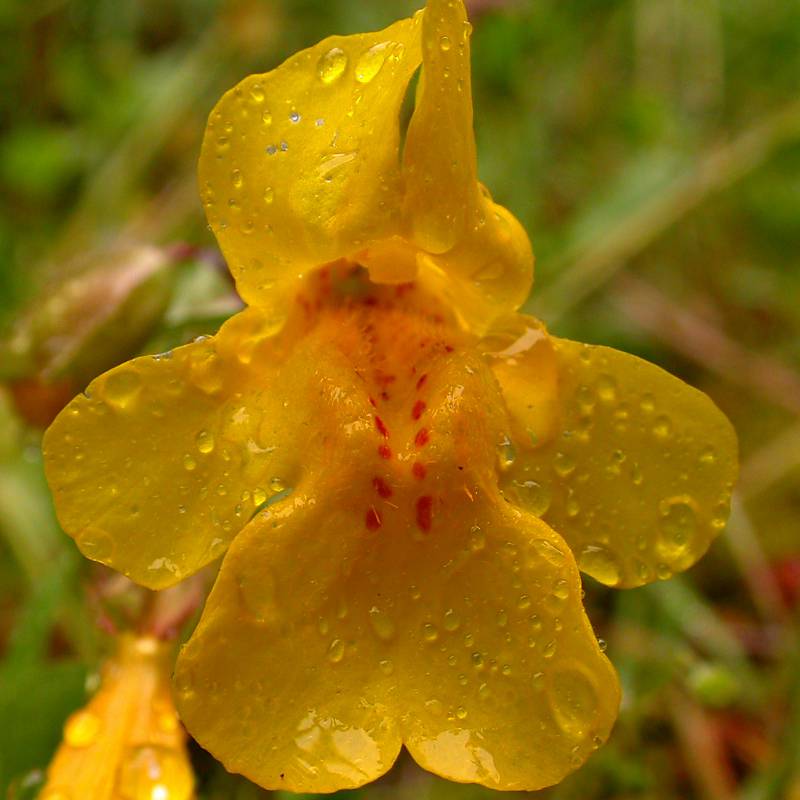Erythranthe microphylla
Erythranthe grandis
small-leaved monkey-flower
large monkey-flower
Leaves basal and cauline, basal leaves occasionally deciduous by flowering;
petioles 3-5 mm from base to mid-stem, becoming sessile and nearly clasping to perfoliate distally;
blade commonly somewhat purple, narrowly ovate to ovate to elliptic to nearly orbicular, 10-35 mm long and 3-25 mm broad, palmate venation with 3-5 veins, base rounded to wedge or nearly heart-shaped, margins more or less crenate or nearly serrate with 5-10 teeth per side, basal and lower cauline leaves irregularly incised near base becoming nearly lyrate;
apex acute to obtuse-rounded, surfaces glabrous or with sparse to moderate coverage of small rigid hairs, eglandular.
Leaves basal and cauline, basal leaves generally not persistent;
petioles 10-80 mm, becoming reduced distally;
blade ovate to broadly elliptic, 25-60 mm long and 20-40 cm broad, palmate or nearly pinnate venation with 5-7 veins, base truncate to nearly cruneate to nearly cordate, margins crenulate to toothed, occasionally sublyrate near base, apex rounded to obtuse, surfaces of distalmost leaves hairy as stems.
Axillary flowers 1-8, emerging from nodes towards ends of stems; fruiting pedicels 8-30 mm, hairy-glandular as stems;
calyx nodding at 30-90 degrees, occasionally somewhat reddish or red-dotted, ovoid-campanulate to widely cylindric-campanulate, inflated, compressed across sagittal plane, usually 9-16 mm, hirtellous or glabrous, throat closing weakly or strongly;
corollas yellow to dark yellow to orangish yellow, typically with red spots, lower limb occasionally with large red splotch, symmetric bilaterally, bilabiate;
tube-throat widely funnel-shaped, 8-16 mm, protruding 2-6 mm beyond calyx margin;
limb expanded 8-25 mm, palate villous;
styles slightly hirtellous;
anthers not protruding, glabrous.
Inflorescence racemose, bracteate, flowers 8-26; fruiting pedicels 10-35 mm, hairy as stems;
calyx straight-erect or nodding at 45-100 degrees, ovate to bell-shaped, inflated, compressed along sagittal plane, 15-22 mm, hairy as stems, throat closing;
corollas yellow with red spots inside, symmetric bilaterally, bilabiate;
tube-throat widely funnel-shaped, 16-24 mm, protruding 10-15 mm beyond calyx margin, limb widely expanded;
styles hirtellous;
anthers not protruding, glabrous.
Capsules 6-9 mm, included.
Capsules 8-12 mm, included.
Erythranthe microphylla
Erythranthe grandis
- Local floras:
BC,
CA,
OR,
WA
- Local Web sites:
CalFlora,
CalPhotos,
Flora NW,
PNW Herbaria
WildflowerSearch
iNaturalist (observations)
- LBJ Wildflower Center
- SEINet
- Plants of the World Online
- Encyclopedia of Life
- Wikipedia
- Google Image Search
- Local floras:
CA,
OR,
WA
- Local Web sites:
CalFlora,
CalPhotos,
Flora NW,
PNW Herbaria
WildflowerSearch
iNaturalist (observations)
- LBJ Wildflower Center
- SEINet
- Plants of the World Online
- Encyclopedia of Life
- Wikipedia
- Google Image Search



